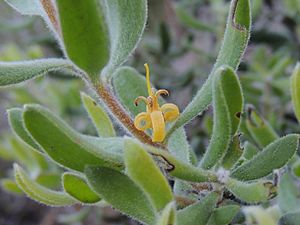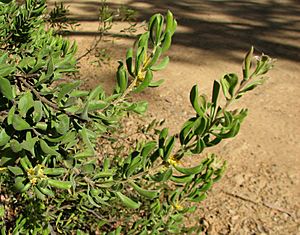Rigid geebung facts for kids
Quick facts for kids Rigid geebung |
|
|---|---|
 |
|
| In the Rob Roy Range Nature Reserve, A.C.T. | |
| Scientific classification | |
| Genus: |
Persoonia
|
| Species: |
rigida
|
| Synonyms | |
|
|
The Rigid Geebung (scientific name: Persoonia rigida) is a special type of flowering plant. It is also known as the hairy geebung or stiff geebung. This plant belongs to the Proteaceae family and is found only in south-eastern Australia. It usually grows as a shrub, from small and low to taller and upright. Its young branches are hairy, and its leaves can be shaped like a spear or a spoon. The Rigid Geebung has yellow flowers that grow in groups. These flowers appear on a stem that can be up to 90 millimeters (about 3.5 inches) long. This stem keeps growing even after the flowers bloom!
Contents
What Does the Rigid Geebung Look Like?
The Rigid Geebung is a shrub that can grow from about 15 centimeters (6 inches) to 2 meters (6.5 feet) tall. Its branches and leaves are covered in fine hairs when they are young. The leaves are usually shaped like a spear, wider at the top and narrower at the base, or like a spoon. They are about 1.5 to 5 centimeters (0.6 to 2 inches) long and 0.4 to 1.9 centimeters (0.16 to 0.75 inches) wide. The edges of the leaves often curve downwards.
The yellow flowers grow in groups of up to twenty. They are found on a main stem called a rachis, which can be up to 90 millimeters long. Each flower sits on a tiny stalk, called a pedicel, which is 1 to 3 millimeters long. A small leaf is usually found at the base of each flower's stalk. The flower petals, called tepals, are yellow and about 10 to 12 millimeters long. They are hairy on the outside, but the part that holds the seeds (the ovary) is smooth. Rigid Geebungs usually flower from November to March. Many of their flowers turn into fruit, which is quite common for this plant compared to other similar species.
How Scientists Name and Group the Rigid Geebung
The Rigid Geebung was first collected in 1804 by a person named George Caley. Later, in 1830, a Scottish botanist named Robert Brown officially described and named it. He wrote about it in his book called Supplementum.
Scientists place the Rigid Geebung in the Persoonia group. Specifically, it's part of the "lanceolata" group. This group includes 54 types of plants that are very similar in their flowers but have different kinds of leaves. Plants in this group often mix their genes (or "interbreed") if they grow near each other.
Where Does the Rigid Geebung Grow?
The Rigid Geebung is found in south-eastern Australia. It grows from the Liverpool Range in central New South Wales down into mid-western Victoria. You can find it on the inland side of the Great Dividing Range, which is a large mountain range. However, it also grows further east in places like Springwood in the Lower Blue Mountains. It prefers to grow at altitudes between 300 and 1300 meters (about 980 to 4265 feet) above sea level.
This plant likes to grow in rocky or sandy soils. It is often found in dry sclerophyll forests or heathlands. Sometimes, the Rigid Geebung can even create new types of plants by mixing with other geebung species. For example, it can hybridize with the prickly geebung (P. juniperina) and P. sericea. In Victoria, it often grows alongside trees like Eucalyptus macrorhyncha and Eucalyptus polyanthemos.
Can You Grow Rigid Geebung in Your Garden?
People tried to grow the Rigid Geebung in gardens in England as early as 1824. However, it is not very common in gardens today. It doesn't have many features that make it a popular plant for home gardeners.


